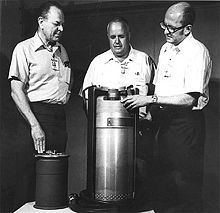Zebra package
The zebra package consisted of 141 mines with nuclear warheads , which the US Army planned to use as a barrier in the event of an attack on the inner-German border during the Cold War . They had an explosive force of between 0.1 and 10 kilotons of TNT equivalent each . ( Hiroshima bomb : approx. 13 kilotons).
commitment
The Atomic Demolition Munition should in case of an invasion of the Warsaw Pact to West Germany within two hours by V. US Corps in the Fulda Gap (114 warheads) and Kinzig (27 warheads) in prepared pits are detonated to the opponent stop at bottlenecks (bridges, motorways, tunnels).
The advantages of using nuclear mines were seen in a higher efficiency (less personnel, time and explosives required than with conventional explosive charges), as well as in a lower strength (and thus less contamination ) than with nuclear weapons with carrier systems , since the accuracy is not a problem .
The American television company CBS produced the film "Defense of the United States" (Part 2: " The Nuclear Battlefield ") in 1981 , in which the use of the Zebra package was discussed.
See also
literature
- Peace Office East Hesse (Ed.): Fulda-Gap. World War III could begin here. Fulda, 1984.
- Knut Krusewitz, Heike Maul: From the Fulda Gap to a UNESCO model region? Rhön Biosphere Reserve, 2001, ISBN 3-936201-00-5 , p. 13.
- Alfred Mechtersheimer , Peter Barth: Militarization Atlas of the Federal Republic. Luchterhand, Darmstadt 1986, ISBN 3-472-61608-3 .
- Michael thresholds: hare and hedgehog. In: THE TIME. September 14, 1984, No. 38.
